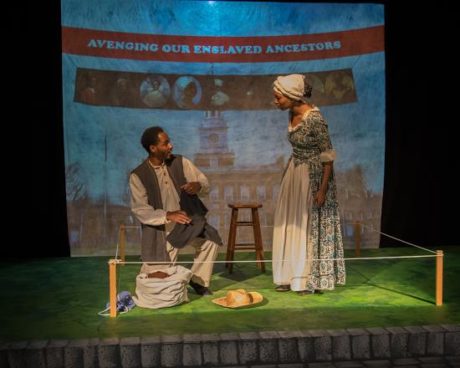Confederate statues are toppled because they ignite memories of slavery. Colleges are compelled to rename buildings because their namesakes turned out to be slaveholders.
Theater companies must choose their seasons months in advance. Who was it at Old Academy Players that had the crystal ball that made their current offering, Thomas Gibbons’ A House with No Walls, reflect the daily news so clearly? It’s hard to remember seeing a play that seemed so timely.

Gibbons’ play was first presented in 2007 in Philadelphia and then picked up by regional theaters throughout the country. The author specializes in plays that dramatize national problems through a Philadelphia perspective. His best knows works are 6221, a staging of the MOVE crisis, and Permanent Collection, about the behind-the-scenes shenanigans at the Barnes Foundation.
A House with No Walls refers to The President’s House Site on Market Street, which is part of Independence National Historical Park in downtown Philadelphia. It prominently displays information that George Washington, during his first term as president, was an active slaveholder. He realized that if his slaves lived in the free state of Pennsylvania for more than six months they would automatically become free. Washington cleverly had his slaves visit their home in Mount Vernon, Virginia to keep them slaving in Philadelphia, which was then the nation’s capital. He specifically hid this information from them and, like all slaveholders, forbade education and the ability to read. When one of his wife’s servants escaped to New England, he went to extraordinary lengths to have her recaptured.
The politicians and city planners were eager, in 2003, to keep their money-making museum from reflecting unpleasant truths. African American Philadelphians insisted that slavery is a part of historical reflection, and a battle ensued.
Gibbons’ play dramatizes this in a striking manner. A character named Salif marks the tiny area of Washington’s slave quarters with string, and places a banner above with pictures of the slaves that lived there (most of their last names are unknown). To Salif, these people should be remembered along with the founding fathers. Historians, both white and black, for whom history is a living breathing event, join him. Soon Gibbons has the slaves appear in their period costumes and start to live in the house with no walls. Two stories emerge, one about the need to honestly discuss history, and the other about the slaves dealing with their complex existence.
Along the way Gibbons discusses many things, such as the need for more African Americans in colleges, or what it means to be a “moderate conservative Republican,” or how you must phrase particular sound bites that will get you on television. This generates a lot of talk, and one audience member commented at the intermission that the play should have been shortened.
I disagree. The playwright has a lot to say, and he says it well. Such a work that spans generations needs an extraordinary company of designers and performers to pull it off. Old Academy’s group is better at the simple, personal stories than the long didactic speeches. This is no problem for Maurice Tucker who plays Salif with just the right touch of outrage. Whether he is bullhorning the crowd with his message, or arguing with a professor about the difficulties of young blacks in current society, he brings a total commitment to the character and generates sympathy for his beliefs.
Ciara Williford dominates the 1797 story as a simple girl who wants to learn to read. The scene where she discusses the life of a slave with her less contemplative brother (Hyresh Davis) is a touching highlight. Her decision to escape Philadelphia is not taken lightly and adds to the suspense of the evening. Hopefully director Carla Childs will continue to work with the other cast members to achieve this level of commitment.
Childs is also credited as designer of set, costumes and lights (with Jesse Friedman, and Helga Krauss). The costumes illuminate the modern characters (Salif first appears with a Bob Marley t-shirt) and illustrates the class consciousness of the earlier era (Washington’s slaves were well dressed). The lighting effectively changes as the play moves to its many locations.
Co-Designer Friedman has made some effective updates to the aging theater building. He has updated the website (you can finally order tickets online), upgraded the sound, and added a system that allows projected scenery. The projections (Philadelphia scenes) work very effectively in the blackouts and when the performers are far downstage, but are washed out when the action moves upstage. Gibbons obviously imagined a larger playing area than the tiny one at Old Academy. Childs and Friedman have not managed to effectively cram all the settings and ghosts onto the small platform, which results in some awkward staging.

None of this keeps Gibbons’ themes from emerging with power and grace. A House with No Walls will stimulate much conversation and disagreement about the divide between races in this city. This is a splendidly written play that will certainly enhance your next visit to the Liberty Bell.
Running Time: Two hours and 20 minutes, with an intermission.
A House with No Walls plays through Sunday September 24, 2017 at Old Academy Players – 3544 Indian Queen Lane, in Philadelphia, PA. For tickets, call the box office at (215) 843-1109, or purchase them online.




